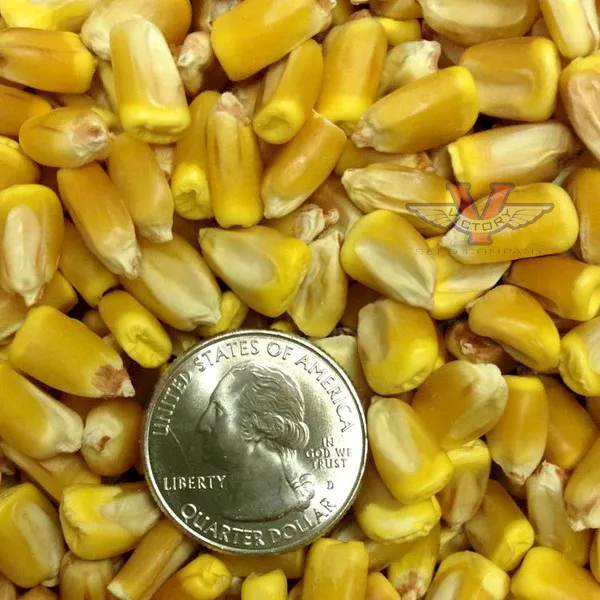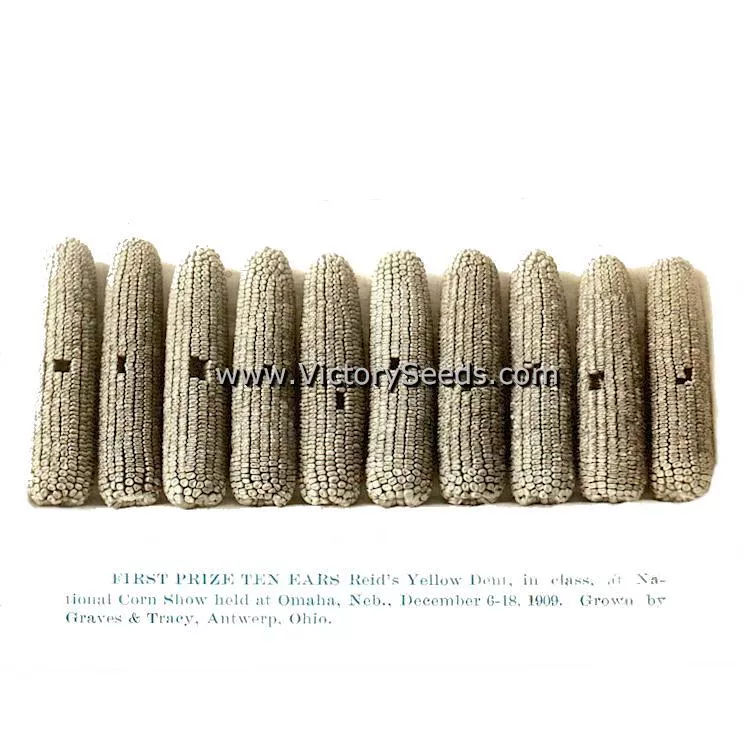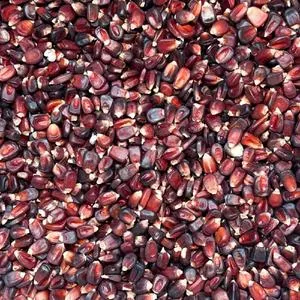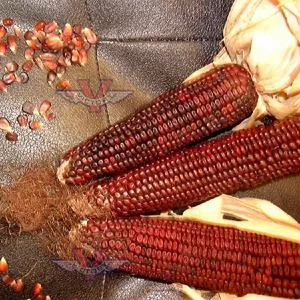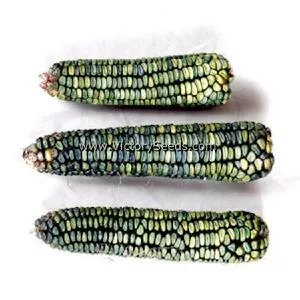

Reid's Yellow Dent Corn
Zea mays subsp. mays
Price: $3.33
SKU: 31400711Choose a variant:
115 days - At one time, 'Reid's Yellow Dent' corn was the most popular variety in the corn belt.[2] It is a medium maturing variety, has big ears of large yellow kernels with good shuck coverage. Mainly used for flour, meal, and feed.
Robert Reid and his son James developed the variety after moving from Ohio to Tazwell County, Illinois in 1846. He brought with him a large, late red corn known as 'Gordon Hopkins'. The following year a poor stand of this variety was obtained and the missing hills were replanted to an early yellow dent corn grown extensively in Tazwell County.
A natural cross between the varieties resulted, from which James L. Reid developed 'Reid's Yellow Dent'. Fifty years of careful and systematic selection have firmly established in this variety certain characteristics. No other corn breeds as true to type as does 'Reid Yellow Dent'.[1]
One of the earliest commercial listings that we have found described 'Reid's Yellow Dent as follows"
Robert Reid and his son James developed the variety after moving from Ohio to Tazwell County, Illinois in 1846. He brought with him a large, late red corn known as 'Gordon Hopkins'. The following year a poor stand of this variety was obtained and the missing hills were replanted to an early yellow dent corn grown extensively in Tazwell County.
A natural cross between the varieties resulted, from which James L. Reid developed 'Reid's Yellow Dent'. Fifty years of careful and systematic selection have firmly established in this variety certain characteristics. No other corn breeds as true to type as does 'Reid Yellow Dent'.[1]
One of the earliest commercial listings that we have found described 'Reid's Yellow Dent as follows"
"This is the grandest yellow corn we ever saw. We believe it is the very best variety for Northern and Central Illinois, Iowa and similar latitudes. We do not recommend it for Wisconsin, although we have grown it here three seasons and it has always ripened.
Reid's Yellow Dent was the Grand Sweepstakes Corn at Illinois State Fair in 1895, as grown and selected for more than 30 years in North Central Illinois. It was also awarded First Premium as "Best Bushel of Corn, any Variety," out of 77 entries at Janesville Mid-Winter Fair in 1898 as exhibited by us. The ears are long, 10 to 12 inches, and the kernels very compact in the row, making it a very solid corn. Color, a deep golden yellow. Stalks are very large and tall, but ears are very large too."[4]
Reid's Yellow Dent was the Grand Sweepstakes Corn at Illinois State Fair in 1895, as grown and selected for more than 30 years in North Central Illinois. It was also awarded First Premium as "Best Bushel of Corn, any Variety," out of 77 entries at Janesville Mid-Winter Fair in 1898 as exhibited by us. The ears are long, 10 to 12 inches, and the kernels very compact in the row, making it a very solid corn. Color, a deep golden yellow. Stalks are very large and tall, but ears are very large too."[4]
Special Groups: Market Growers
Genetic Classification: Open Pollinated
Genetic Classification: Open Pollinated
Planting Instructions:
Soil must be at least 65ºF to germinate. Be patient and do not plant too early or you will waste a lot of seed! Plant in full sun and keep it watered. Corn is a wind-pollinated plant. Plant in blocks several rows wide to ensure full ears.
Sow seeds about 1½ to 2½ inch deep, 3 to 4 inches apart, in rows spaced 24 to 30 inches apart. Thin to 6 to 12 inches apart.
Harvest Information:
Pick the ears for dry grain or decoration when the husks are dry and the kernels are hard enough that you cannot make a dent in them with your fingernail. Many people pick the ears too early when kernels are still soft. If this is done they shrivel up and shrink and their beauty is destroyed. They cannot finish maturing once they have been picked.
Even though the ears look dry, there remains moisture deep within the cob. If you were to enclose them in a box, the moisture would cause them to sour and mold. You may let them dry longer on the plants if neither weather nor predators are damaging them. Otherwise hang them up or lay them out in the open until they are completely dry inside.
Sow seeds about 1½ to 2½ inch deep, 3 to 4 inches apart, in rows spaced 24 to 30 inches apart. Thin to 6 to 12 inches apart.
Harvest Information:
Pick the ears for dry grain or decoration when the husks are dry and the kernels are hard enough that you cannot make a dent in them with your fingernail. Many people pick the ears too early when kernels are still soft. If this is done they shrivel up and shrink and their beauty is destroyed. They cannot finish maturing once they have been picked.
Even though the ears look dry, there remains moisture deep within the cob. If you were to enclose them in a box, the moisture would cause them to sour and mold. You may let them dry longer on the plants if neither weather nor predators are damaging them. Otherwise hang them up or lay them out in the open until they are completely dry inside.
Informational Resources:
- "Varieties of Corn in Kansas," Kansas Agricultural Experiment Station, Bulletin 227, 1921.
- "Corn Production in Kansas," Kansas Agricultural Experiment Station, Bulletin 238, 1926.
- "Obituary of James L. Reid," SaveSeeds.org.
- "L. L. Olds Seed Catalog," L. L. Olds Seed Company, Clinton, Wisconsin, 1899.
Customer Reviews:
Do you have experience with this one? 📝 📣 Write a review!
No reviews have been posted yet.

